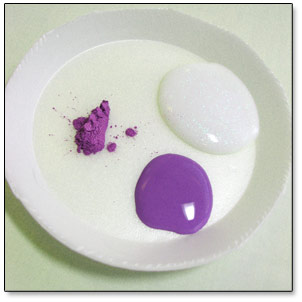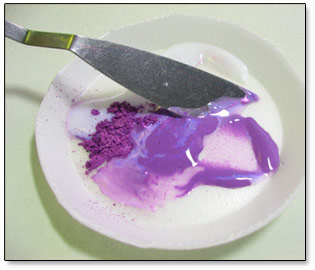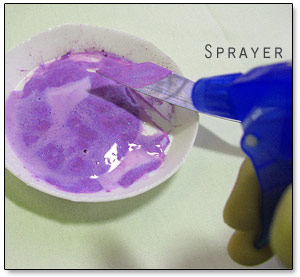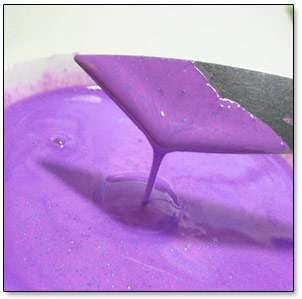As I prepared my canvas for the CyberPointers Stitch-A-Long (SAL) – Midnight Garden project, I took a few pictures to share with you. This is a tutorial for painting a canvas with a tint or wash of color. It is an excellent way to distinguish, and customize your project when you use stitches that intentionally expose the canvas threads.
The process is not difficult, and not very expensive if you already have some acrylic paint supplies on hand. The results will be quite suitable for most projects, and mistakes can be used for projects that fully cover the canvas with stitches. For certain specific designs, I personally use an airbrush to achieve more controlled color transitions or stenciled edges. And for detail work, I would hand render the illustration on canvas.
Setup and Supplies Needed:
-
A protected work surface
-
Cut canvas piece (edges do not need to be finished)
-
Paint mixing surface – styrofoam meat tray, old plate; something that has upturned edges, but is essentially flat
-
Spray bottle with water
-
Wide mouth container
-
Mixing knife or palette knife – should be the flexible style
-
Applicators (one or more of these) : a “chip” brush – inexpensive about 1 – 2 inches wide, piece of cellulose sponge, scrap of terry washcloth
-
Acrylic paints in squeeze bottles or tubes – smooth consistency paints are easier to mix properly, avoid the full body acrylics
-
Acrylic mediums – choose one from: a liquid gel medium, textile medium, or “flow” medium
-
Glitter additive
-
Plain water and clean up supplies
Now, lets get started . . .
Lesson #1 Mix Your Paint and Medium
Above you see a squeeze of paint, a puddle of gel medium (with sparkle glitter already mixed in) and a dollop of Pearl-X powder. The mixture needs at least equal parts paint and gel, but sometimes the less costly paints have less pigment, so more paint may be necessary.
I added the Pearl-X powder as an effect.
The result: absolutely NO effect at all.
On the other hand, the glitter gel was exactly the thing to make sparkles galore.
– – – – – – – – – – – – – – – – – – – – – – – – – – – – – – – – – – – – – – – – – – – – – – – – – – – – – – – –
Note 1: This glitter gel was on sale, normally I would have used plain liquid gel or textile medium and added glitter sparkles directly into the mixture.
Note 2: The amount of paint mixed was not enough to cover my 10 x 10 inch canvas to my satisfaction. As you will see in Part 2 of the tutorial, I mixed some additional paint to finish the job. Be sure to mix enough paint especially if mixing two or more paint colors to get the hue you want. It is hard to get an exact match the second time around.
– – – – – – – – – – – – – – – – – – – – – – – – – – – – – – – – – – – – – – – – – – – – – – – – – – – – – – – –
Mix the ingredients with the palette knife. Use a sideways motion to scoop the mix together, then flatten the blade of the knife on top of the pile to squeeze it. Repeat the scoop and flatten method until it is very consistent in color and texture.
– – – – – – – – – – – – – – – – – – – – – – – – – – – – – – – – – – – – – – – – – – – – – – – – – – – – – – – –
So far, we have not added any water to the mix, but now is the time to begin to loosen it with water. Use the spray mister, set on fine mist, to add water. Give one spritz at a time and then mix with the palette knife. Our first target consistency is like very heavy cream.
The consistency shown above is well mixed with no trace of paint flecks, and can be tested by looking for a solid, thin stream of paint coming off the palette knife.
Final Mixing Step:
One more addition of water is need to thin the consistency to a milk-like thickness – that would be whole milk, not low fat.
If your mixing palette is too shallow, now is the time to pour the paint into the wide mouth container, and add a little water at a time.
– – – – – – – – – – – – – – – – – – – – – – – – – – – – – – – – – – – – – – – – – – – – – – – – – – – – – – – –



